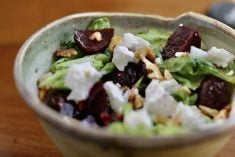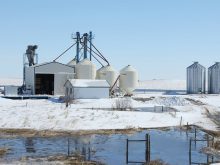Harvest is under way. I’m thinking beyond harvest and making a list of things I need help with around the yard. My husband is not aware of this list. I’ll keep it a surprise.
Putting up a clothesline is on the list. I used to like using the clothesline when we lived at the farm. I’ve managed for five years in our new yard in town without one, so should I bother with one now?
One problem is where to put it. The most inconspicuous place is over the garden but that won’t work well when the corn grows tall.
Read Also

Communication key to bridging generation gap
Each generation is shaped by the predominant forces at play during their formative years. Acknowledging these influences can improve communication among the generations.
There is a satisfaction in hanging nice clean clothes, side by side on the clothesline. The clothes smell so nice when dried outside. In our part of Saskatchewan we have lots of wind to blow out the wrinkles. More often the problem is too much wind, as we race to get the clothes off the line before the neighbours are wearing them.
Statistics show Saskatchewan has more sunshine than any other province. And because our air is usually so dry, the first clothes onto the line will be dry before we finish the basket. Sask Power says that hanging just one load of laundry on the line per week, instead of using a dryer, will save $20 a year.
There are many stories about clotheslines. It has been rumoured that Monday mornings, ladies used to hurry so they could be the first to get their laundry on the line, even sneaking it out Sunday night.
Canning low acid foods
I often get phone calls from home canners inquiring about how long to process vegetables or meats in a boiling water canner. The times are not given in home canning books for a good reason; they cannot be safely processed that way. They are low acid foods and must be heat processed in a pressure canner to avoid botulism poisoning.
- What are low acid foods? They are vegetables, meat and game, poultry, seafood, soups, sauces, stews, clamato juice, tomato vegetable mixtures, tomato-meat and meat sauces. Any food or recipe that has a pH greater than 4.6 is a low acid food.
- High acid foods include fruits, jams, jellies and fruit spreads. Figs and tomatoes are on the borderline between high and low acid status and therefore require the addition of acid to be safely processed in a boiling water canner. Fermented foods, such as sauerkraut and fermented pickles, as well as pickled recipes to which a sufficient quantity of vinegar is added, are also considered high acid foods. Other recipes combine high and low acid ingredients but include sufficient quantities of acid ingredients such as vinegar, citric acid or lemon juice, to achieve a 4.6 pH or lower. Examples include pickles, relishes, chutney and condiments. These foods can be processed in a boiling water canner.
- Botulism is a deadly form of food poisoning caused by ingestion of the toxin produced by spores of the bacterium Clostridium botulinum. It may be found in soil, water, animals, contaminated food or agricultural products. A contaminated jar may not look or smell bad and so it could be eaten unknowingly.
- How can botulism food poisoning be prevented? The bacteria are destroyed at boiling temperatures, but it can form hardy spores that can survive the temperature of boiling water. A higher heat of 240 F (116 C) is needed to prevent the growth of the spores. The only way for a home canner to achieve this temperature is in a pressure canner. No matter how long you boil a jar in a boiling water canner, the temperature of the boiling water, 212 F (100 C), is as high a temperature as the food in the jar gets. That’s not high enough to kill the botulinum spores.
- Botulism is not a problem in high acid foods because the spores do not grow in the presence of acid. While botulism poisoning is rare, Health Canada reported seven cases in 1998, eight cases in 1999 and four cases in 2000. Nausea and vomiting usually appear within six to 36 hours. Other symptoms might include the inability to swallow, speech difficulty and finally paralysis, which could lead to death.
- “But my mother used to always can low acid foods in a boiling water canner instead of a pressure canner, why can’t I?” Mother was lucky that no one got sick. You may be, too, but the consequences are too great. Also, the world is “smaller” now than it was years ago. Food and people travel all over and the organisms are more likely to be spread from place to place. Don’t take any chances with botulism poisoning.
Stovetop rice pudding
Dear TEAM: Quite a few years ago I got a recipe from the Producer for rice pudding. I have lost it and would like to find it again. It was great. It took two cups of leftover rice and was cooked on the top of the stove and was quick and easy. – P.R., Saskatoon, Sask.
Dear P.R.: We could not find a stovetop recipe in past Western
Producers, but I think this is
the recipe you want.
11/2 cups cooked rice 375 mL
2 cups milk, divided 500 mL
1/3 cup sugar 75 mL
2/3 cup raisins 150 mL
1/4 teaspoon salt 1 mL
1 egg, beaten
1 tablespoon butter 15 mL
1/2 teaspoon vanilla 2 mL
dash nutmeg or cinnamon
Combine rice and 11/2 cups (375 mL) milk, sugar, raisins and salt in a heavy saucepan or double boiler. Cook over medium heat. Stir occasionally until thick and creamy, 15-20 minutes. Blend remaining 1/2 cup (125 mL) milk and egg. Stir into rice mixture. Cook two minutes longer, stirring occasionally. Add butter and vanilla. Spoon into serving dishes. Sprinkle with nutmeg or cinnamon, if desired. Serves four.
Freezer coleslaw
Dear Team: In the Sept. 16, 2004 Western Producer, I noticed the heading “refrigerator coleslaw recipes.” I thought you might appreciate the following recipe that I have used for several years, taken from your paper. I find that when I have part of a jar of coleslaw and some leftover beets, I grate the beets before cooking and throw the beets in the jar. It makes a good mixture. – F. W., Georgetown, Ont.
Dear F.W.: Thanks so much for sending us this clipping from Emmie Oddie’s column, printed in the Producer in 1979 or 1980.
Freezer coleslaw
3 pounds cabbage 1.5 kg
2 medium carrots
2 medium onions
Shred vegetables and sprinkle with 1/2 cup (125 mL) sugar. Let stand eight to 12 hours.
Dressing
1 cup vinegar 250 mL
1 cup white sugar 250 mL
1 cup salad oil 250 mL
2 teaspoons celery seed 10 mL
11/2 teaspoons salt 7 mL
Boil dressing mixture and pour over vegetables. Put in containers, close tightly, freeze.
Spoiled pickles
Dear TEAM: In one paper a lady was complaining about her pickles spoiling and going slimy. Some reasons are the year and the conditions of the weather. They are
important. Also, Cool Breez and Amira cukes are for eating only and if you try pickling them, they go soft and sometimes slimy. – L.B., Minitonas, Man.
Rack system
Dear TEAM: I have just finished reading your column in the Western Producer (Aug. 25, 2005) where you talk about the Cook’s Helper rack system for canning. I have a canner without a rack and my canner does not have a flat bottom, which I need for my cooktop. Apparently one can purchase this from the Bernardin canning company, but where would I find one of these racks? – E.E., Yorkton, Sask.
Dear E.E.: Betty Ann purchased her Cook’s Helper rack system for home canning and cooking from Canadian Tire in Saskatoon. They should be available wherever Bernardin canning supplies are sold. You can also order them on-line from Bernardin through its website at www.homecanning.com/can or 888-430-4231. The set of two racks sells for about $16.
Alma Copeland is a home economist from Elrose, Sask., and one of four columnists comprising Team Resources. Send correspondence in care of this newspaper, Box 2500, Saskatoon, Sask., S7K 2C4 or contact them at team@producer.com.














